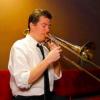A quarrel broke out at Davies Symphony Hall.
No, it wasn’t one San Francisco Symphony patron taking on another when a cellphone went off. This combat flared up musically, in the Friday, Oct. 3 world premiere of Timothy Higgins’ combustive short piece Market Street, 1920s, a Symphony commission.
Posing one rather straightlaced theme against another that is more loose-limbed and jazz-inflected, the composer let the two collide to see what happened.
Far from a train wreck, the eight-minute work came off as a leap of madcap invention, the themes cunningly overlaid and interlocked in volleys of cacophonous counterpoint. A large percussion ensemble of multiple drums, cymbals, a ratchet, xylophone and more drove home the pulsing polyrhythms. Stravinsky came to mind. So did Prokofiev. Guest conductor Gustavo Gimeno led the performance with a clear beat and dynamic command.
Hard to take in at a first hearing, as many new works are, Market Street was nonetheless more than heavy traffic. It calmed down for a bit and offered some welcoming entry points. In one of them, the up-to-then orderly first violins caught on to the jazz theme and kidnapped it for a while before bouncing it back to the brasses.
Higgins, the Symphony’s principal trombone since 2008 who this fall assumes that post with the Chicago Symphony, introduced the work from the stage on Friday. He recalled finding its title when someone told him it made them think of vintage footage of San Francisco streetcars crowding Market Street. In the piece’s ending, with both themes still squaring off, unresolved, Higgins noted a parallel to our current partisan politics.
But the bulk of the concert was given over to two deeply familiar works — Tchaikovsky’s Symphony No. 5 and Edvard Grieg’s Piano Concerto in A Minor. (For the record, the Tchaikovsky piece was last performed here in 2021 and the Grieg in 2023.)
The symphony was the evening’s high point. Make that many high points, as Gimeno led a performance marked by power, grace and fresh insight.
It began when the woodwinds picked up the work’s throughline theme over swaying strings. The effect was like a boat setting out for a long voyage. The brasses added their full-throated send-off.
Then Gimeno led the way into deeper waters, signaling for the basses to sing out more at one point. That was part of building a weighty lower foundation that prevailed throughout the piece.
The trombones had an especially fine night, and the horns and woodwinds equaled them, opening the second movement with a mellow exchange that rose in majesty and amplitude. Everything felt fully realized, from the cellos’ lyrical surges to the ripe pizzicati.
The graceful waltz made its first steps with a fresh voicing of the opening measures. Later, a pair of snarky muted trumpets were like a couple of yokels sniggering from the edge of the dance floor.
Gimeno pounced on the final movement without a pause. Everything moved with a sense of inevitability. He couldn’t help basking in it all, throwing his arms out wide partway through, letting the orchestra take care of itself for a few measures. Indeed, the strikingly handsome, elegant Spanish conductor has a showman’s gift on top of his musical chops.
Javier Perianes was the pianist in Grieg’s concerto. He announced his presence right away, powering through the opening chord passage. What followed was a bright, slightly brittle reading of the work.
The solo passages emerged with clarity and keen technique, right down to tight trills and tremolos. But the phrasing and dynamics lacked distinction, and the performance missed a connection between orchestra and soloist, despite some strong orchestral playing.
As an encore, Perianes gentled his way through the Notturno from Grieg’s “Lyric Pieces.” It made a soft landing for a concert marked by plenty of high-voltage music.




